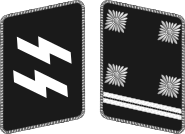
SS-Obersturmbannführer Manfred Schönfelder of the Waffen-SS
Obersturmbannführer was a paramilitary Nazi Party rank used by both the SA and the SS. It was created in May 1933 to fill the need for an additional field grade officer rank above Sturmbannführer as the SA expanded. It became an SS rank at the same time.[1] Translated as “senior assault (or storm) unit leader”,[2] Obersturmbannführer was junior to Standartenführer and was the equivalent to Oberstleutnant (lieutenant colonel) in the German Army.[3] The insignia for Obersturmbannführer was four silver pips and a stripe, centered on the left collar of an SS/SA uniform.[4] The rank also displayed the shoulder boards of a Wehrmacht Oberstleutnant and was the highest SS/SA rank to display unit insignia on the opposite collar.[5]
Notable recipients[]
Amongst the more notorious holders of the rank of Obersturmbannführer were Rudolf Höss, Adolf Eichmann, Herbert Kappler and Joachim Peiper. Höss was commandant of the infamous Auschwitz concentration camp, whilst Eichmann is generally regarded as a key architect of the Nazi's Endlösung (Final Solution) policy in which Auschwitz played so major a role. Herbert Kappler was the head of German police and security services (Oberbefehlshaber des Sicherheitspolizei und SD) in Rome who conducted the infamous Ardeatine massacre. Joachim Peiper was the commander of the eponymous Kampfgruppe responsible for the Malmedy massacre during the December 1944 Battle of the Bulge.[6]
Eichmann was promoted to Obersturmbannführer in 1940 and was listed as such in the minutes of the Wannsee Conference that began the Endlösung. During Eichmann's trial for war crimes in 1962, chief prosecutor Gideon Hausner drew attention to the significance and responsibility of Eichmann's Obersturmbannführer rank when, in response to Eichmann's claim that he was merely a clerk obeying orders, Hausner asked him, “Were you an Obersturmbannführer or an office girl?”[citation needed]
In Eichmann in Jerusalem, however, Hannah Arendt disputes the notion that Obersturmbannführer was a rank of significance, pointing out that Eichmann spent the war "dreaming" about promotion to Standartenführer. Arendt also points out that "...people like Eichmann, who had risen from the ranks, were never permitted to advance beyond a lieutenant colonel [i.e., the rank of Obersturmbannführer] except at the front."[7]
- Insignia of rank of Obersturmbannführer of the Waffen-SS
| Junior Rank Sturmbannführer |
SS rank and SA rank Obersturmbannführer |
Senior Rank Standartenführer |
See also[]
Notes[]
- ↑ McNab 2009, pp. 29, 30.
- ↑ McNab (II) 2009, p. 15.
- ↑ Yerger 1997, p. 236.
- ↑ Flaherty 2004, p. 148.
- ↑ Lumsden 2000, p. 110.
- ↑ Toland 1999, p. 382.
- ↑ Arendt 2006, p. 147.
Bibliography[]
- Arendt, Hannah (2006). Eichmann in Jerusalem. Penguin Classics.
- Flaherty, T. H. (2004) [1988]. The Third Reich: The SS. Time-Life Books, Inc. ISBN 1 84447 073 3.
- Lumsden, Robin (2000). A Collector's Guide To: The Waffen–SS. Ian Allan Publishing, Inc. ISBN 0-7110-2285-2.
- McNab, Chris (2009). The SS: 1923–1945. Amber Books Ltd. ISBN 1906626499.
- McNab (II), Chris (2009). The Third Reich. Amber Books Ltd. ISBN 978-1-906626-51-8.
- Toland, John (1999). Battle: The Story of the Bulge. Lincoln: University of Nebraska Press. ISBN 0-8032-9437-9.
- Yerger, Mark C. (1997). Allgemeine-SS: The Commands, Units and Leaders of the General SS. Schiffer Publishing Ltd.. ISBN 0-7643-0145-4.
External links[]
![]() The dictionary definition of Obersturmbannführer at Wiktionary
The dictionary definition of Obersturmbannführer at Wiktionary
The original article can be found at Obersturmbannführer and the edit history here.


